
A whorl is a single, complete 360° revolution or turn in the spiral or whorled growth of a mollusc shell. A spiral configuration of the shell is found in numerous gastropods, but it is also found in shelled cephalopods including Nautilus, Spirula and the large extinct subclass of cephalopods known as the ammonites.
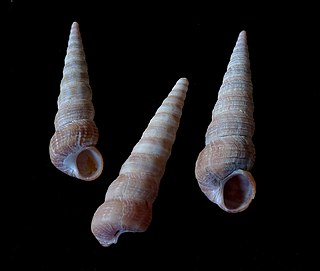
A spire is a part of the coiled shell of molluscs. The spire consists of all of the whorls except for the body whorl. Each spire whorl represents a rotation of 360°. A spire is part of the shell of a snail, a gastropod mollusc, a gastropod shell, and also the whorls of the shell in ammonites, which are fossil shelled cephalopods.

The umbilicus of a shell is the axially aligned, hollow cone-shaped space within the whorls of a coiled mollusc shell. The term umbilicus is often used in descriptions of gastropod shells, i.e. it is a feature present on the ventral side of many snail shells, including some species of sea snails, land snails, and freshwater snails.
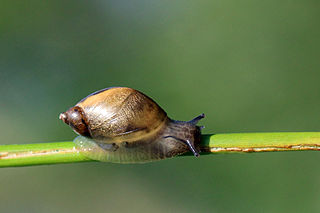
Succinea, common name the amber snails, is a large genus of small, air-breathing land snails, terrestrial pulmonate gastropod molluscs in the family Succineidae.

The gastropod shell is part of the body of a gastropod or snail, a kind of mollusc. The shell is an exoskeleton, which protects from predators, mechanical damage, and dehydration, but also serves for muscle attachment and calcium storage. Some gastropods appear shell-less (slugs) but may have a remnant within the mantle, or in some cases the shell is reduced such that the body cannot be retracted within it (semi-slug). Some snails also possess an operculum that seals the opening of the shell, known as the aperture, which provides further protection. The study of mollusc shells is known as conchology. The biological study of gastropods, and other molluscs in general, is malacology. Shell morphology terms vary by species group.

Aegista is a genus of air-breathing land snails, terrestrial pulmonate gastropod mollusks in the family Camaenidae.

Vertigo ovata, common name the ovate vertigo, is a species of minute, air-breathing land snail, a terrestrial pulmonate gastropod mollusk in the family Vertiginidae, the whorl snails.

Cyclophoridae is a taxonomic family of small to large tropical land snails with an operculum, terrestrial gastropod mollusks in the order Architaenioglossa belonging to the subclass Caenogastropoda.
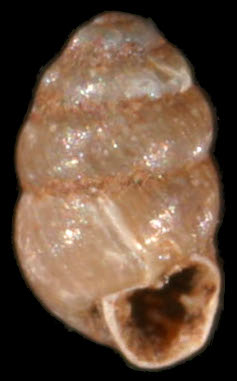
Vertigo pygmaea, common name the "crested vertigo", is a species of minute air-breathing land snail, a terrestrial pulmonate gastropod mollusk in the family Vertiginidae, the whorl snails.

Bradybaena is a genus of small, air-breathing land snails, or terrestrial molluscs in the family Bradybaenidae.
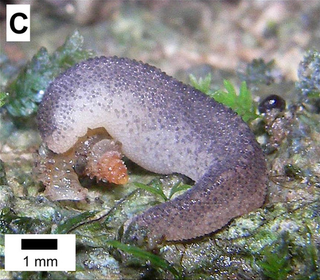
Rathouisiidae is a family of carnivorous air-breathing land slugs, terrestrial pulmonate gastropod mollusks in the superfamily Veronicelloidea, the leatherleaf slugs and their allies.
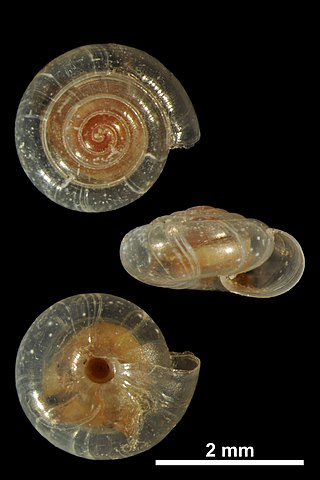
Vitrea contracta, the milky crystal snail, is a species of small, air-breathing land snail, a terrestrial pulmonate gastropod mollusk in the family Pristilomatidae.
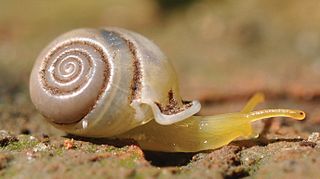
Perrottetia is a genus of air-breathing land snails, terrestrial pulmonate gastropod mollusks in the family Streptaxidae.

Cantharidus antipodum is a species of sea snail, a marine gastropod mollusk in the family Trochidae, the top snails.
Rathouisia pantherina is a species of carnivorous air-breathing land slug, terrestrial pulmonate gastropod mollusk in the family Rathouisiidae.
Cassinia furtiva is a species of flowering plant in the family Asteraceae and is endemic to a restricted area of New South Wales. It is a shrub with hairy, sticky stems, narrow linear leaves and 100 to 150 flower heads arranged in a rounded dichasium.

Cipangopaludina cathayensis is a species of large, freshwater snail with an operculum and a gill, an aquatic gastropod mollusk in the family Viviparidae, the river snails.

Aegista accrescens is a species of air-breathing land snails, a terrestrial pulmonate gastropod in the family Camaenidae.
Aegista aubryana is a species of air-breathing land snails, a terrestrial pulmonate gastropod in the family Camaenidae.

Aegista herpestes is a species of air-breathing land snails, a terrestrial pulmonate gastropod in the family Camaenidae.
















